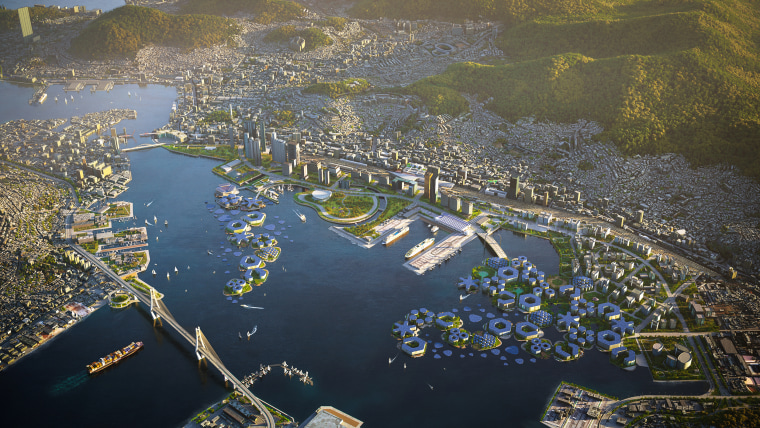Next year, a small city is expected to begin rising on the ocean surface along the coast of Busan, South Korea, with the capacity to hold 12,000 people.
The floating city is backed by the United Nations Human Settlements Program, which is advising the project's stakeholders and plans to eventually collect data on how it operates.
The city is meant to serve as a kind of test of a new model of real estate development. The project’s leaders, a sustainable design startup called Oceanix, said the city should be able to withstand 100-year storms, with a foundation that rises as sea levels do.
The design plans, presented Tuesday at a U.N. roundtable, call for three platforms: one to hold housing, one for public spaces like schools and theaters, and a third for research and development related to floating cities. Each platform would connect to the others and to land via bridges, and would be anchored to the ocean floor with removable pile moorings.
The platforms would be coated in a buoyant limestone material called Biorock that is harder than concrete. The buildings, at no more than five stories, would be made of lightweight, sustainable materials like timber and bamboo. There will not be any traditional cars or trains, with residents and visitors traveling on bicycle or foot.
Oceanix solicited private investment to fund the project, which is estimated to cost $10,000 per square meter. At 15.5 acres, that’s around $627 million. Construction is expected to take two years, making completion unlikely before 2025. The platforms will be assembled on land first, then towed to the water.
Oceanix initially proposed a floating city concept at a U.N. roundtable in 2019, and Busan signed on to host it in November.
"Meetings like this one are not empty talk," Maimunah Mohd Sharif, executive director of the U.N. Human Settlements Program, said in a statement on Tuesday. "Three years ago at our first roundtable, everyone wondered when they might visit a floating city or see its revolutionary architecture, experience its zero-waste environment, sample its home-grown produce and enjoy a new way of living sustainably with nature. We now have the answer. Plans are in place."

The project's lead architect, Bjarke Ingels, said more platforms could be added to the development later.
"We imagine that it could be the seed of a kind of floating new neighborhood that over time could grow," he said.
The designers intend for the city to grow food, produce solar energy and collect and filter fresh water. Cages built into the underside of the platforms would be able to harvest scallops or kelp.
If the development is successful, similar platforms could be commissioned and built elsewhere, in places like the Maldives, Dubai, Monaco, Lagos, Rio de Janeiro, Miami or New York.
"The first prototype is always more expensive because you don’t have scale behind you," said Gaetano Crupi, a partner at Prime Movers Lab, an investor in the project. "In the long run, we believe that these platforms can be scaled to be very viable all over the world."
